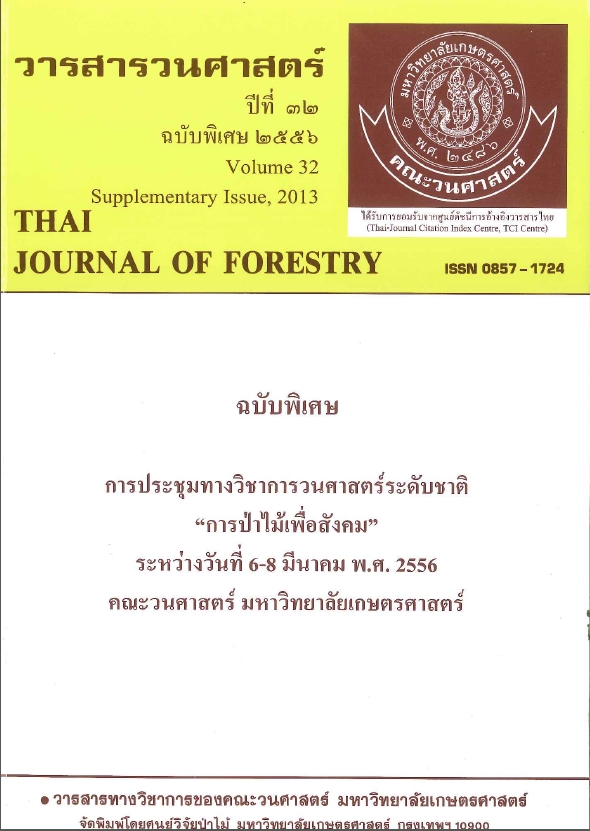การกักเก็บคาร์บอนในป่าผลัดใบที่มีความถี่ของไฟแตกต่างกัน บริเวณเขตรักษาพันธุ์สัตว์ป่าห้วยขาแข้ง จังหวัดอุทัยธานี
Main Article Content
บทคัดย่อ
การศึกษาวิจัย การกักเก็บคาร์บอนในป่าผลัดใบที่มีความถี่ของไฟแตกต่างกันในเขตรักษาพันธุ์สัตว์ป่าห้วยขาแข้ง จังหวัดอุทัยธานี มีวัตถุประสงค์เพื่อศึกษาลักษณะโครงสร้างสังคมพืชในป่าผลัดใบ และมวลชีวภาพและปริมาณการกักเก็บคาร์บอนของแต่ละแปลงตัวอย่างโดยทำการวางแปลงตัวอย่างถาวรแปลงมีขนาด 90 x 90 เมตรจำนวน 5 แปลง ประกอบด้วยความถี่ของไฟ 5 ความถี่คือ แปลงเผาทุกปี (M2) แปลงเผาเว้น 1 ปี (M5) แปลงเผาเว้น 2 ปี (M9) แปลงเผาเว้น 4 ปี (M1) และแปลงควบคุมไฟ (M10) และวางแปลงตัวอย่างย่อยขนาด 10 x 10 เมตร เพื่อเก็บข้อมูลไม้ยืนต้น และวางแปลงตัวอย่างย่อยขนาด 4 x 4 เมตร เพื่อเก็บข้อมูลไม้รุ่น ทำการวัดขนาดเส้นผ่านศูนย์กลางเพียงอก (DBH) และความสูงทั้งหมด (H) ของไม้ใหญ่และไม้รุ่น วิเคราะห์ดัชนีความสำคัญทางนิเวศวิทยาของพรรณไม้ในพื้นที่ (Importance value index, IVI) และประเมินมวลชีวภาพโดยใช้สมการแอลโลเมตรี (allometry) และการกักเก็บคาร์บอนในมวลชีวภาพ
ผลการศึกษาในแปลงตัวอย่างทั้ง 5 แปลงพบไม้ใหญ่ทั้งสิ้น 74 ชนิดโดยชนิดไม้ที่มีดัชนีความสำคัญทางนิเวศวิทยามากที่สุด 5 อันดับแรกได้แก่ ตะคร้อ เปล้าใหญ่ ตะแบกดง ปอแดง ปอลาย และแดง ตามลำดับ ทั้งนี้ยังพบว่าเต็ง ซึ่งเป็นพรรณไม้ที่พบมากในป่าเต็งรังยังเป็นไม้ที่มีดัชนีความสำคัญทางนิเวศวิทยาในระดับที่สูงในแปลงเผาเว้น 1 และ 2ปีอีกด้วย ในขณะที่พบไม้รุ่นทั้งหมด 61 ชนิด โดยทั้ง 5 แปลงตัวอย่างพบพรรณไม้ที่มีดัชนีความสำคัญทางนิเวศวิทยามากเหมือนกัน 5 ชนิด คือ เปล้าใหญ่ ปอแดง ปอลาย เสี้ยวดอกขาว และตะแบกดง
จากการศึกษายังพบพบว่ามวลชีวภาพและการกักเก็บคาร์บอนในมวลชีวภาพของทั้ง 5 แปลงมีความแตกต่างกันอย่างมีนัยสำคัญทางสถิติ (p-value<0.05) โดยมวลชีวภาพและการกักเก็บคาร์บอนในมวลชีวภาพของแปลงเผาเว้น4ปีมีค่ามากที่สุดเท่ากับ 191.431 และ 91.887 ตันต่อเฮกแตร์ตามลำดับ เนื่องจากมีขนาดเส้นผ่านศูนย์กลางและความสูงเฉลี่ยมากที่สุด สำหรับมวลชีวภาพและการกักเก็บคาร์บอนในมวลชีวภาพของไม้รุ่น ทั้ง 5 แปลงตัวอย่างนั้นมีความแตกต่างกันอย่างมีนัยสำคัญทางสถิติ (p-value<0.05) โดยแปลงที่มีการควบคุมไฟมีปริมาณมวลชีวภาพและการกักเก็บคาร์บอนมากที่สุด เท่ากับ 1.687 และ 0.810 ตันต่อเฮกแตร์ ถึงแม้ว่าความหนาแน่นของจำนวนไม้วัยรุ่นจะน้อยกว่าแปลงเผาเว้น 4 ปี อาจเป็นเพราะไม้รุ่นมีขนาดเส้นผ่านศูนย์กลางและความสูงมีมากกว่า จะเห็นได้ว่าแปลงที่มีความถี่ของไฟที่น้อยนั้นจะมีมวลชีวภาพและการกักเก็บคาร์บอนในมวลชีวภาพของไม้รุ่นที่ค่อนข้างมากเนื่องจากในระยะยาวไม้วัยรุ่นสามารถปรับตัวและเติบโตได้ดีภายหลังจากการเกิดไฟ อย่างไรก็ตามจำเป็นต้องมีการศึกษาการเปลี่ยนแปลงของมวลชีวภาพและปริมาณการกักเก็บคาร์บอนเพื่อวิเคราะห์อิทธิพลของความถี่ไฟต่อมวลชีวภาพและปริมาณการกักเก็บคาร์บอนของป่าแห่งนี้
คำสำคัญ: ความถี่ของไฟ ลักษณะโครงสร้างสังคมพืช มวลชีวภาพ การกักเก็บคาร์บอน ป่าผลัดใบ
Downloads
Article Details

อนุญาตภายใต้เงื่อนไข Creative Commons Attribution-NonCommercial-NoDerivatives 4.0 International License.
ข้าพเจ้าและผู้เขียนร่วม (ถ้ามี) ขอรับรองว่า ต้นฉบับที่เสนอมานี้ยังไม่เคยได้รับการตีพิมพ์และไม่ได้อยู่ในระหว่างกระบวนการพิจารณาตีพิมพ์ลงในวารสารหรือสิ่งตีพิมพ์อื่นใด ข้าพเจ้าและผู้เขียนร่วม (ถ้ามี) ยอมรับหลักเกณฑ์และเงื่อนไขการพิจารณาต้นฉบับ ทั้งยินยอมให้กองบรรณาธิการมีสิทธิ์พิจารณาและตรวจแก้ต้นฉบับได้ตามที่เห็นสมควร พร้อมนี้ขอมอบลิขสิทธิ์ผลงานที่ได้รับการตีพิมพ์ให้แก่วารสารวนศาสตร์ คณะวนศาสตร์ มหาวิทยาลัยเกษตรศาสตร์ กรณีมีการฟ้องร้องเรื่องการละเมิดลิขสิทธิ์เกี่ยวกับภาพ กราฟ ข้อความส่วนใดส่วนหนึ่ง หรือ ข้อคิดเห็นที่ปรากฏในผลงาน ให้เป็นความรับผิดชอบของข้าพเจ้าและผู้เขียนร่วม (ถ้ามี) แต่เพียงฝ่ายเดียว และหากข้าพเจ้าและผู้เขียนร่วม (ถ้ามี) ประสงค์ถอนบทความในระหว่างกระบวนการพิจารณาของทางวารสาร ข้าพเจ้าและผู้เขียนร่วม (ถ้ามี) ยินดีรับผิดชอบค่าใช้จ่ายทั้งหมดที่เกิดขึ้นในกระบวนการพิจารณาบทความนั้น”


